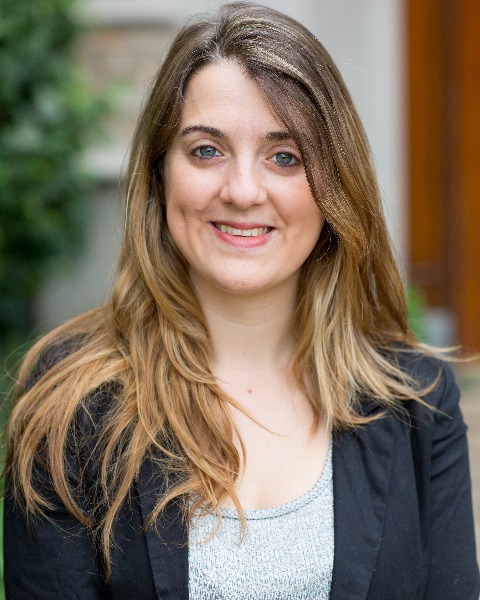Back
INFECTION/MICROBIOLOGY
Poster Session
(562) Low-frequency ultrasound significantly increases inactivation efficiency in Pseudomonas aeruginosa biofilms
Thursday, November 3, 2022
12:00 PM – 12:40 PM ET

yanina F. Nahum (she/her/hers)
PhD Candidate
University of Notre Dame
South Bend, Indiana, United States- NG
Neila Gross
United States
- AC
Albert Cerrone
United States
- RN
Robert Nerenberg
United States
Presenting Author(s)
Co-Author(s)
Background: There is a critical need for new therapies to manage cystic fibrosis (CF) lung infections. The nidus of infection is the biofilm — an aggregate of bacteria embedded in a protective layer of extracellular polymeric substances that is very difficult to treat. This is because biofilms are highly resistant to antibiotics [1]. Low-frequency ultrasound (LFU) in conjunction with antibiotics (here called “combination therapy”) can greatly increase the bactericidal effect of antibiotics against biofilms. Although some research on LFU has been done on biofilms, the mechanisms giving rise to this synergistic effect (those related to pharmacokinetics, cell metabolism, and bacterial efflux) are not well understood.
The focus of the presented research is cell inactivation of Pseudomonas aerigunosa biofilms subjected to combination therapy. It unveils the spatiotemporal distribution of cell viability under combination therapy as well as biofilm characteristics that could impact the efficiency of combination therapy. Based on these results, hypotheses are formulated regarding the salient mechanisms giving rise to the enhancement.
Methods: Tobramycin and ultrasound probe Qsonica Q125 were used as antibiotic and LFU method, respectively. Biofilms grown under flow in vitro for 5 days were stained using LIVE/DEAD viability kit and observed under confocal microscope Nikon A1R.
Results: Figure 1 compares the effect of antibiotic-only treatment and combination therapy of P. aeruginosa biofilms over the course of two hours. Without LFU, the inactivation was limited to the outer parts of the biofilm, while the inner biofilm remained mostly unaltered over time. Contrarily, the right-side plot indicates the effect that combination therapy has on P. aeruginosa biofilms. It is clear that an initial 60-sec dose of LFU complemented by a two-hour treatment of tobramycin results in more complete cell inactivation. Not only is cell death faster, but inactivation extends deeper into the biofilm, reaching the inner portions. It is noteworthy that the regimen of LFU is not sufficient to disrupt the biofilm. In other words, the increased cell inactivation is not the result of blunt mechanical force.
The preliminary results of this research show the spatiotemporal distribution of cell viability when combination therapy is applied. It suggest possible cellular / molecular mechanisms giving rise to the enhanced inactivation from combination therapy. The fact that cell inactivation occurs deeper in biofilms under combination therapy might indicate an enhanced diffusion of the antibiotics. On the other hand, it could be that LFU is increasing the metabolic activity of otherwise dormant cells in the deeper regions of the biofilm, making them more susceptible to the antibiotics. There is also the possibility that combination therapy might be overwhelming bacterial efflux mechanisms.
Conclusions: Ultimately, these results motivate a comprehensive study of biofilm behavior invoking both mechanics (e.g. mass diffusion) and cellular / molecular processes (e.g. bacterial efflux) to assess the mechanisms that lead to the synergistic effect.
Acknowledgements:
References: [1] M. Simões, L. C. Simões, and M. J. Vieira, “A review of current and emergent biofilm control strategies,” LWT - Food Sci. Technol., vol. 43, no. 4, pp. 573–583, 2010, doi: 10.1016/j.lwt.2009.12.008
The focus of the presented research is cell inactivation of Pseudomonas aerigunosa biofilms subjected to combination therapy. It unveils the spatiotemporal distribution of cell viability under combination therapy as well as biofilm characteristics that could impact the efficiency of combination therapy. Based on these results, hypotheses are formulated regarding the salient mechanisms giving rise to the enhancement.
Methods: Tobramycin and ultrasound probe Qsonica Q125 were used as antibiotic and LFU method, respectively. Biofilms grown under flow in vitro for 5 days were stained using LIVE/DEAD viability kit and observed under confocal microscope Nikon A1R.
Results: Figure 1 compares the effect of antibiotic-only treatment and combination therapy of P. aeruginosa biofilms over the course of two hours. Without LFU, the inactivation was limited to the outer parts of the biofilm, while the inner biofilm remained mostly unaltered over time. Contrarily, the right-side plot indicates the effect that combination therapy has on P. aeruginosa biofilms. It is clear that an initial 60-sec dose of LFU complemented by a two-hour treatment of tobramycin results in more complete cell inactivation. Not only is cell death faster, but inactivation extends deeper into the biofilm, reaching the inner portions. It is noteworthy that the regimen of LFU is not sufficient to disrupt the biofilm. In other words, the increased cell inactivation is not the result of blunt mechanical force.
The preliminary results of this research show the spatiotemporal distribution of cell viability when combination therapy is applied. It suggest possible cellular / molecular mechanisms giving rise to the enhanced inactivation from combination therapy. The fact that cell inactivation occurs deeper in biofilms under combination therapy might indicate an enhanced diffusion of the antibiotics. On the other hand, it could be that LFU is increasing the metabolic activity of otherwise dormant cells in the deeper regions of the biofilm, making them more susceptible to the antibiotics. There is also the possibility that combination therapy might be overwhelming bacterial efflux mechanisms.
Conclusions: Ultimately, these results motivate a comprehensive study of biofilm behavior invoking both mechanics (e.g. mass diffusion) and cellular / molecular processes (e.g. bacterial efflux) to assess the mechanisms that lead to the synergistic effect.
Acknowledgements:
References: [1] M. Simões, L. C. Simões, and M. J. Vieira, “A review of current and emergent biofilm control strategies,” LWT - Food Sci. Technol., vol. 43, no. 4, pp. 573–583, 2010, doi: 10.1016/j.lwt.2009.12.008
